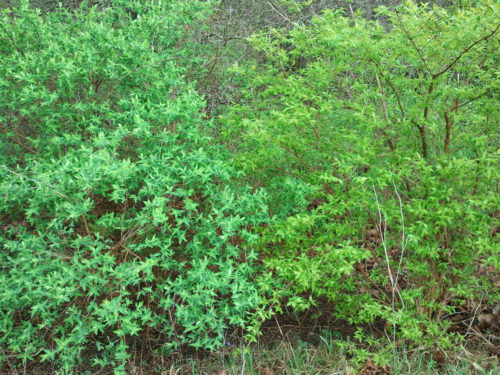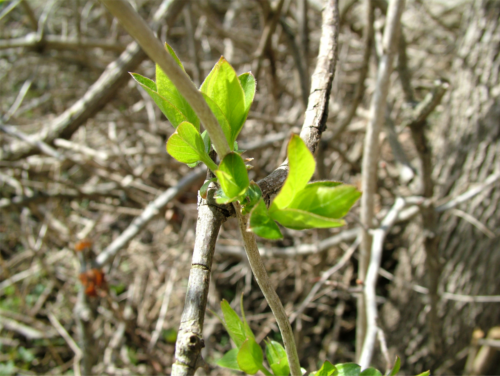 Purdue University - Extension - Forestry and Natural Resources
Purdue University - Extension - Forestry and Natural Resources
Got Nature? Blog
The longer daylight period and the warming weather are bringing new life to woodlands. We have a community of native plants, called spring ephemerals, that grow, bloom, and produce seed quickly before the tree leaves emerge and the forest understory is wrapped in shade. Several of my favorite wildflowers are in this group, including hepaticas, trilliums, bloodroot, squirrel-corn, and trout lily.
Some unwelcome invaders also emerge early in the spring, producing early foliage and an unnatural shade competing with our native plants. Several woody invasive plants have moved into our woodlands from ornamental and other plantings and now compete aggressively with our natives. These include Asian bush honeysuckles, privets, winged burning bush, and multiflora rose. These plants tend to produce foliage faster than most of our native trees and shrubs, proving them with a competitive advantage through a longer growing season. This early leaf emergence also provides us with an opportunity to identify these invaders in our woodlands. When walking out to observe the wildflowers or hunt for morels, keep your eyes open for the invasive plants. Small specimens can be pulled when soils are moist. Larger specimens may be cut and the stump treated with a herbicide to prevent sprouting. An easy and effective herbicide to access for landowners is glyphosate concentrate products mixed at a 50% ratio with water. Apply this mixture to the cut stump immediately after cutting. Read the herbicide label to understand the protective gear and application instructions required to apply safely.
If you have a large infestation that is beyond your capacity to control, consider contacting a local forester or other natural resources professional for advice on how best to deal with your invasive plant problem. You may contact the Indiana DNR Division of Forestry for advice from the District Forester. Private-sector foresters and environmental groups and contractors may also be able to help you manage invasive species on your property. To find a private-sector forester visit www.findindianaforester.org. You can find environmental groups and contractors, and additional information on invasives at the Indiana Invasive Species Council website. Purdue Extension has many invasive species resource publications and videos that can help with identification and management.
Controlling invasive plants can bring a sense of satisfaction, knowing you are doing something to promote the health and sustainability of your property.
To view more Got Nature? posts on Invasive Species:
What are invasive species and why should I care?
Invasive Species: the Good News and the Bad News
Resources
Indiana DNR Division of Forestry
Indiana Invasive Species Council
Report Invasive, Purdue Extension
Invasive Plant Series: Winged Burning Bush, The Education Store, Purdue Extension’s resource center
Burning Bush Video, The Education Store, Purdue Extension’s resource center
What Nurseries Need to Know About the Invasive Species Regulation, The Education Store, Purdue Extension’s resource center
Invasive plants: impact on environment and people, The Education Store, Purdue Extension’s resource center
Lenny Farlee, Sustaining Hardwood Extension Specialist
Purdue University Department of Forestry and Natural Resources

Recent Posts
- From Forest to Classroom – 2024 NRTI Class
Posted: July 26, 2024 in Community Development, Forestry, Urban Forestry, Wildlife - Virtual Tour Brings Forest Management for Birds to Life
Posted: July 19, 2024 in Forestry, How To, Publication, Wildlife - Summer Tree Care – Purdue Landscape Report
Posted: July 16, 2024 in Forestry, Forests and Street Trees, How To, Plants, Urban Forestry - DNR State Deer Biologist Shares Population Ecology of Deer-IFWOA Webinar
Posted: July 12, 2024 in Forestry, Wildlife, Woodlands - Buoys Keep Eye on Great Lake Conditions
Posted: July 11, 2024 in Aquatic/Aquaculture Resources, Great Lakes, How To - ID That Tree: Learn to Identify Conifer Leaf Types
Posted: in Forestry, Forests and Street Trees, How To, Urban Forestry, Wildlife - ID That Tree: Types of Broadleaved Tree Leaves
Posted: July 10, 2024 in Forestry, Forests and Street Trees, How To, Plants, Wildlife - 2024 Turkey Brood Count Wants your Observations – MyDNR
Posted: June 28, 2024 in Alert, Community Development, Wildlife - Case Study: Maple Tree Pests – Purdue Landscape Report
Posted: June 26, 2024 in Disease, Forests and Street Trees, Plants, Spiders, Urban Forestry, Wildlife, Woodlands - Woodland Management Moment: Oak Regeneration – Protecting Seedlings
Posted: June 24, 2024 in Forestry, Urban Forestry, Wildlife, Woodland Management Moment, Woodlands
Archives
Categories
- Alert
- Aquaculture/Fish
- Aquatic/Aquaculture Resources
- Ask the Expert
- Christmas Trees
- Community Development
- Disease
- Drought
- Forestry
- Forests and Street Trees
- Gardening
- Got Nature for Kids
- Great Lakes
- How To
- Invasive Animal Species
- Invasive Insects
- Invasive Plant Species
- Land Use
- Natural Resource Planning
- Nature of Teaching
- Plants
- Podcasts
- Ponds
- Publication
- Safety
- Spiders
- Timber Marketing
- Uncategorized
- Urban Forestry
- Webinar
- Wildlife
- Wood Products/Manufacturing
- Woodland Management Moment
- Woodlands

